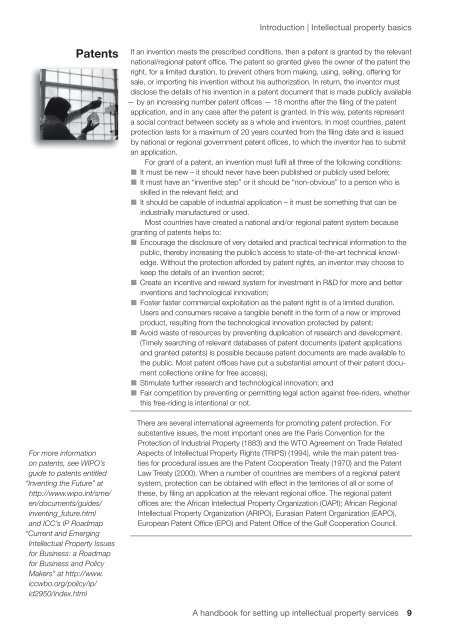Making intellectual property work for business - World Intellectual ...
Making intellectual property work for business - World Intellectual ...
Making intellectual property work for business - World Intellectual ...
You also want an ePaper? Increase the reach of your titles
YUMPU automatically turns print PDFs into web optimized ePapers that Google loves.
Patents<br />
For more in<strong>for</strong>mation<br />
on patents, see WIPO’s<br />
guide to patents entitled<br />
“Inventing the Future” at<br />
http://www.wipo.int/sme/<br />
en/documents/guides/<br />
inventing_future.html<br />
and ICC’s IP Roadmap<br />
“Current and Emerging<br />
<strong>Intellectual</strong> Property Issues<br />
<strong>for</strong> Business: a Roadmap<br />
<strong>for</strong> Business and Policy<br />
Makers” at http://www.<br />
iccwbo.org/policy/ip/<br />
id2950/index.html<br />
Introduction | <strong>Intellectual</strong> <strong>property</strong> basics<br />
If an invention meets the prescribed conditions, then a patent is granted by the relevant<br />
national/regional patent office. The patent so granted gives the owner of the patent the<br />
right, <strong>for</strong> a limited duration, to prevent others from making, using, selling, offering <strong>for</strong><br />
sale, or importing his invention without his authorization. In return, the inventor must<br />
disclose the details of his invention in a patent document that is made publicly avail able<br />
— by an increasing number patent offices — 18 months after the filing of the patent<br />
application, and in any case after the patent is granted. In this way, patents represent<br />
a social contract between society as a whole and inventors. In most countries, patent<br />
protection lasts <strong>for</strong> a maximum of 20 years counted from the filing date and is issued<br />
by national or regional government patent offices, to which the inventor has to submit<br />
an application.<br />
For grant of a patent, an invention must fulfil all three of the following conditions:<br />
■■<br />
It must be new – it should never have been published or publicly used be<strong>for</strong>e;<br />
■■<br />
It must have an “inventive step” or it should be “non-obvious” to a person who is<br />
skilled in the relevant field; and<br />
■■<br />
It should be capable of industrial application – it must be something that can be<br />
industrially manufactured or used.<br />
Most countries have created a national and/or regional patent system because<br />
granting of patents helps to:<br />
■■<br />
Encourage the disclosure of very detailed and practical technical in<strong>for</strong>mation to the<br />
public, thereby increasing the public’s access to state-of-the-art technical knowledge.<br />
Without the protection af<strong>for</strong>ded by patent rights, an inventor may choose to<br />
keep the details of an invention secret;<br />
■■<br />
Create an incentive and reward system <strong>for</strong> investment in R&D <strong>for</strong> more and better<br />
inventions and technological innovation;<br />
■■<br />
Foster faster commercial exploitation as the patent right is of a limited duration.<br />
Users and consumers receive a tangible benefit in the <strong>for</strong>m of a new or improved<br />
product, resulting from the technological innovation protected by patent;<br />
■■<br />
Avoid waste of resources by preventing duplication of research and development.<br />
(Timely searching of relevant databases of patent documents (patent applications<br />
and granted patents) is possible because patent documents are made available to<br />
the public. Most patent offices have put a substantial amount of their patent document<br />
collections online <strong>for</strong> free access);<br />
■■<br />
Stimulate further research and technological innovation; and<br />
■■<br />
Fair competition by preventing or permitting legal action against free-riders, whether<br />
this free-riding is intentional or not.<br />
There are several international agreements <strong>for</strong> promoting patent protection. For<br />
substantive issues, the most important ones are the Paris Convention <strong>for</strong> the<br />
Protection of Industrial Property (1883) and the WTO Agreement on Trade Related<br />
Aspects of <strong>Intellectual</strong> Property Rights (TRIPS) (1994), while the main patent treaties<br />
<strong>for</strong> procedural issues are the Patent Cooperation Treaty (1970) and the Patent<br />
Law Treaty (2000). When a number of countries are members of a regional patent<br />
system, protection can be obtained with effect in the territories of all or some of<br />
these, by filing an application at the relevant regional office. The regional patent<br />
offices are: the African <strong>Intellectual</strong> Property Organization (OAPI); African Regional<br />
<strong>Intellectual</strong> Property Organization (ARIPO), Eurasian Patent Organization (EAPO),<br />
European Patent Office (EPO) and Patent Office of the Gulf Cooperation Council.<br />
A handbook <strong>for</strong> setting up <strong>intellectual</strong> <strong>property</strong> services 9

















